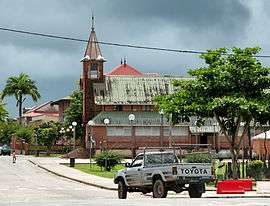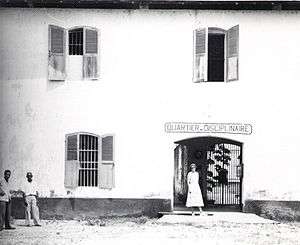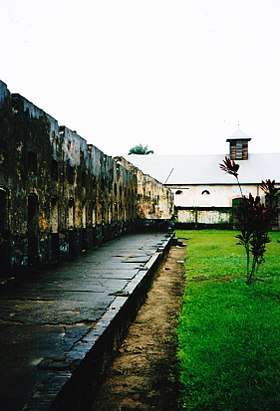Saint-Laurent-du-Maroni
Saint-Laurent-du-Maroni (French pronunciation: [sɛ̃ loʁɑ̃ dy maʁɔni] is a commune of French Guiana, an overseas region and department of France located in South America. Saint-Laurent-du-Maroni is one of the two sub-prefectures of French Guiana and the seat of the Arrondissement of Saint-Laurent-du-Maroni. It is the second most populous city of French Guiana, with 42,612 inhabitants at the January 2017 census.[2]
Saint-Laurent-du-Maroni | |
|---|---|
Subprefecture and commune | |
.jpg)  City hall (top) and Catholic church (bottom) of Saint-Laurent-du-Maroni | |
 Coat of arms | |
Location of the commune (in red) within French Guiana | |
Location of Saint-Laurent-du-Maroni 
| |
| Coordinates: 5°29′58″N 54°01′52″W | |
| Country | France |
| Overseas region and department | French Guiana |
| Arrondissement | Saint-Laurent-du-Maroni |
| Intercommunality | Ouest Guyanais |
| Government | |
| • Mayor (2020-2026) | Sophie Charles (DVD) |
| Area 1 | 4,830 km2 (1,860 sq mi) |
| Population (2017-01-01)[1] | 42,612 |
| • Density | 8.8/km2 (23/sq mi) |
| Time zone | UTC−03:00 |
| INSEE/Postal code | 97311 /97320 |
| 1 French Land Register data, which excludes lakes, ponds, glaciers > 1 km2 (0.386 sq mi or 247 acres) and river estuaries. | |
Geography
Saint-Laurent-du-Maroni is a border town in north-west French Guiana. It is located on the Maroni River (in Dutch: Marowijne), opposite the town of Albina in Suriname which can be reached by ferry or pirogue.[3] It does not, therefore, have an Atlantic coast; this may have motivated the choice of the town's location, as the penal authorities wanted to prevent the escape of prisoners from their islet imprisonments by a sea route.[4]
The ethnic composition of the town is, as everywhere in French Guiana, diverse: Maroons are today the largest ethnic group, followed by Creoles, Amerindians, Haitians, métropolitains and Brazilians.
Maroons will mostly be found in the neighbourhoods called la Charbonnière (Djukas, Saramakas and Paramaccans), les Vampires and les Sables Blancs.[5] Amerindians are located in a few villages on the outskirts of town: Balaté (Arawaks),[6] Paddock, Prospérité, Terre Rouge, Espérance, Village Pierre (Kalinas).[7]
History


Founded in 1858 by Auguste Baudin,[8] it was formerly the arrival point for prisoners, who arrived at the Camp de la Transportation.[9]


The town was near an Amerindian settlement called Kamalakuli[5] named after their chief.[4] On 15 September 1880, the town became the capital city of a special prison commune; the mayor was the Director of the Penitentiary Administration.[8]
When Gaston Monnerville was elected Deputy in 1932, he tried to close the prison complex. On 17 June 1938, the prison was repealed, but the final closure did not come until 1946.[4] On 9 November 1949, Saint-Laurent-du-Maroni became a regular commune.[8]
Transport
Between 1890 and 1897, a 16 kilometre Decauville railway was constructed between Saint-Laurent-du Maroni and Saint-Jean-du-Maroni. Another 22 kilometre railway was built to the Charvein sawmill. The railways were abandoned after the penal camps closed.[10]
Saint-Laurent-du-Maroni can be accessed chiefly by road, the Route Nationale 1, from Cayenne. A new port was recently built on the Maroni, but currently lacks proper wharf infrastructure and sufficient river depth. The Saint-Maurice airfield was decommissioned in 1946, but is used for sports.[11] The Saint-Jean road links Saint-Laurent to Saint-Jean-du-Maroni and the military base there.
In 2010, Route Nationale opened connecting Saint-Laurent-du-Maroni starting from the Plateau des Mines to Apatou. The road was opened with the Tour of Guiana.[12] The road is scheduled to be extended to Maripasoula. Construction work on the section between Apatou and Papaïchton is planned to commence in 2021.[13]
The town is also an important port of departure for those going inland via pirogue or to Albina in Suriname by ferry or pirogue.[14]
Economy
The sugarcane fields near town produce "La Belle Cabresse" rum (as well as the less well-known "La Cayennaise" and "Cœur de Chauffe") for the Saint Maurice rum company.[15] The rum is 50 to 55% proof and of high quality.
On the road to Saint-Jean-du-Maroni (about 17 km (11 mi) south of St-Laurent, home of the former penal Camp de la Rélégation),[16] one can find many small shops owned by Saramakas selling the woodwork for which they are famous - especially chairs and tables. There is also a village of Maroon artisans on the road to Javouhey.
Two military units are stationed at St-Jean's Camp Némo: the Groupement du service militaire adapté (GSMA), which is part of the Ministry of Overseas France and is in charge of professional job reinsertion in the west of French Guiana; and the Maroni detachment of the 9th Marine Infantry Regiment whose job it is to patrol the river border and the jungles of the west of the département.In 2008, the two units has merged into the Regiment of the Adapted Military Service (RSMA).[17]
Environment
This river town has long been the headquarters of an important association for the protection of the environment: "Le pou d'agouti" (an environmental organisation named after an annoying local mite with an itchy bite[18] which strives for the protection of local and regional fauna and flora.
It is also the point of departure for several ecotourism circuits, most notably journeys upriver to explore the many creeks as well as the Amazonian rainforest; tourists can spend a night in the jungle in huts or tents. Another possibility is visiting the Voltaire Falls, situated 70 km (43 mi) upriver.
Industrial activities, slowly increasing urban density and its accompanying shantytowns as well as poaching have damaged the surrounding area, but on 23 May 2009, a species of Caecilian theretofore unknown to man was discovered in town.[19]
Sights
Originally built by, and for, the French department of corrections or Administration Pénitentiaire, many old official buildings in Saint-Laurent-du-Maroni bear a distinctive architectural style, a unique mix of colonial style and penitentiary architecture.[8] Bricks made from the local red clay were used by the convicts, who provided a free and never-ending workforce, to build a whole official and administrative district, starting with the main jailhouse itself, the Camp de la Transportation.[9]
Some of the main buildings in the old administrative district, locally called Le Petit Paris for its alleged reminiscence of a 19th-century French architecture:
- Le Camp de la Transportation (guided tours available, famous for Henri 'Papillon' Charrière's cell) and the adjacent Office du Tourisme;
- La Résidence du Gouverneur du bagne, today's residence of the sous-préfet, and formerly the governor's residence;
- Le Tribunal maritime, today's sous-préfecture;
- La Mairie (city hall) and the former bank;
- The church;
- Le Trésor public;
- L'Hôtel La Tentiaire;
- La caserne Joffre (the Gendarmerie HQ);
- The hospital (France's only wooden hospital still in use).
Most of these buildings are located on Avenue De Gaulle, Avenue Lieutenant-Colonel Tourtet and the Boulevard Mallouet. After the jailhouse was closed and the penal authority left in the early 50s, these buildings suffered from lack of maintenance and interest, and were much damaged due to the harsh weather conditions in western French Guiana. Close to a state of total ruin, they underwent a major restoration in the early 80s, after the city council and French Minister of Culture realized that the old penitentiary and administrative district was of high cultural and historical interest. It soon became a major tourist attraction, with the Camp de la Transportation its star.[20]
Other notable sights from the penitentiary years include Saint-Jean-du-Maroni, formerly the Camp de la Relégation and today's main military HQ for western French Guiana. There is also a small island in the middle of the Maroni River which used to house the prisoners affected with leprosy. Papillon wrote about hiding there during one of his daring escapes.[21]
Notable sights not related to the prisons:
- La Charbonnière: Maroon village founded by refugees from Suriname's civil war.[22]
There are many hotels in St Laurent, including the Auberge Bois Diable, Chez Julienne, Hôtel la Tentiaire, Le Relais des 3 Lacs and Star Hôtel.
Climate
Saint-Laurent-du-Maroni features an equatorial climate that is a tropical rainforest climate (Köppen Af) more subject to the Intertropical Convergence Zone than the trade winds and with no cyclones. The temperatures are uniform throughout the year. It has a copious amount of rain throughout the year, classifying it as a rainforest climate as all months have more than 60 millimetres or 2.36 inches of rain per month, unlike the south and east of French Guiana where the months of September and October are typically drier than this.
| Climate data for St.-Laurent du Maroni | |||||||||||||
|---|---|---|---|---|---|---|---|---|---|---|---|---|---|
| Month | Jan | Feb | Mar | Apr | May | Jun | Jul | Aug | Sep | Oct | Nov | Dec | Year |
| Average high °C (°F) | 28 (82) |
28 (82) |
28 (83) |
28 (83) |
28 (83) |
28 (83) |
29 (84) |
30 (86) |
31 (87) |
31 (87) |
29 (85) |
28 (83) |
29 (84) |
| Average low °C (°F) | 24 (75) |
24 (75) |
24 (76) |
24 (76) |
24 (76) |
24 (75) |
24 (75) |
24 (76) |
24 (76) |
24 (76) |
24 (75) |
24 (75) |
24 (75) |
| Average rainfall mm (inches) | 260 (10.3) |
180 (7.1) |
190 (7.6) |
240 (9.5) |
350 (13.6) |
330 (13) |
250 (9.7) |
170 (6.8) |
110 (4.5) |
100 (4) |
160 (6.3) |
250 (9.7) |
2,590 (102.1) |
| Source: Weatherbase [23] | |||||||||||||
Demographics
Historical population
| year | 1961 | 1967 | 1974 | 1982 | 1990 | 1999 | 2007 | 2012 | 2017 | |||
|---|---|---|---|---|---|---|---|---|---|---|---|---|
| population | 3,019 | 5,031 | 5,055 | 6,971 | 13,616 | 19,211 | 34,149 | 40,597 | 42,612 | |||
| annual increase | +334 | +3 | +259 | +829 | +623 | +1,910 | +1,290 | +403 | ||||
| percentage | +8.9% | +0.1% | +4.4% | +8.7% | +3.9% | +7.6% | +3.5% | +1.0% | ||||
| Official figures from past censuses.[24][2] | ||||||||||||
Migrations
The places of birth of the 43,600 residents in the commune of Saint-Laurent-du-Maroni at the 2015 census were the following:[25]
- 64.1% were born in French Guiana
- 5.3% in Metropolitan France
- 0.9% in Martinique
- 0.5% in Guadeloupe
- 0.2% in other parts of Overseas France
- 29.0% in foreign countries (notably Suriname, followed by Brazil and to a lesser extent Haiti); among these, 28.4% were immigrants and 0.7% were children of French citizens born abroad
These were the countries of birth of the immigrants living in the commune of Saint-Laurent-du-Maroni at the 2009 census:[26]
- born in Suriname: 7,631
- born in Brazil: 3,105
- born in Haiti: 1,199
- born in Guyana: 327
- born in other countries: 530
References in popular culture
Somerset Maugham's short-story, "A Man with a Conscience" is set in St. Laurent de Maroni. As Maugham describes the town: “St Laurent de Maroni is a pretty little place. It is neat and clean. It has an Hotel de Ville and a Palais de Justice of which many a town in France would be proud. The streets are wide, and the fine trees that border them give a grateful shade. The houses look as though they had just had a coat of paint. Many of them nestle in little gardens, and in the gardens are palm trees and flame of the forest; cannas flaunt their bright colours and crotons their variety; the bougainvilleas, purple or red, riot profusely, and the elegant hibiscus offers its gorgeous flowers with a negligence that seems almost affected. St Laurent de Maroni is the centre of the French penal settlement of Guiana, and a hundred yards from the quay at which you land is the great gateway of the prison camp. These pretty little houses in their tropical gardens are the residence of the prison officials, and if the streets are neat and clean it is because there is no lack of convicts to keep them so."[27]
Maugham's short story "An Official Position" is also set in St. Laurent de Maroni. Both stories first appeared in book form in the collection The Mixture as Before (1940). In 1936 Maugham visited the place himself; his notes, including material that was used in both stories, was later published in A Writer's Notebook (1949). This is how he described the executions in his notes:
- When a man is sentenced to death the sentence has to be confirmed by the minister in Paris. No execution takes place on Sunday. If two or more are to be guillotined at the same time the least guilty is executed first so that he should not suffer the added horror of seeing his mates die. The convict does not know that he will be executed till the warder comes in with the words: Have courage, etc. When there are executions the other convicts are depressed and nervous, and they go about their work sullen and silent.
- When the head has fallen the executioner takes it up by the ears and shows it to the bystanders, saying: Au nom du people francais justice est faite. At the side of the guillotine is a large wicker basket covered with some black material and into this the body is put. The knife falls with lightning speed and the blood spurts over the executioner. He is given a set of new clothes after each execution.[28]
See also
- Communes of the Guyane department
- Saint-Jean-du-Maroni, a village in the commune of Saint-Laurent-du-Maroni
References
- "Populations légales 2017". INSEE. Retrieved 6 January 2020.
- INSEE. "Historique des populations communales". Retrieved 2020-04-17.
- "Annonce Ferry Albina - St. Laurent du Maroni MARS 14 et 15,2020". AmbaFrance (in French). Retrieved 7 June 2020.
- "Saint-Laurent du Maroni, Histoire d'une commune". Fier de Tre Guyanais (in French). Retrieved 7 June 2020.
- "Guide Saint-Laurent-du-Maroni". Petit Futé (in French). Retrieved 7 June 2020.
- "Traditional Wayana Crafts : part of humanity's heritage to be protected". Guianas Geographic (in French). Retrieved 7 June 2020.
- "Pluralité linguistique en Guyane : un aperçu". Research Gate (in French). Retrieved 7 June 2020.
- "Historique de Saint-Laurent-du-Maroni". 97320.com (in French). Retrieved 7 June 2020.
- "BAGNE DE SAINT-LAURENT-DU-MARONI - CAMP DE LA TRANSPORTATION". Petit Futé (in French). Retrieved 7 June 2020.
- "Prison Railways in French Guiana, 2014". International Steam. Retrieved 31 May 2020.
- "Aérodrome Saint Maurice, Piste d'aérodrome / d'aéroport à Saint-Laurent-du-Maroni". Web Villes (in French). Retrieved 7 June 2020.
- "La route d'Apatou raccommodée". Guyane la Première (in French). Retrieved 6 June 2020.
- "Route Maripasoula-Papaichton : 1 million d'euros par kilomètre". France Guyane (in French). Retrieved 10 August 2020.
- "Distrikt Marowijne". Suriname.nu (in Dutch). Retrieved 3 June 2020.
- "LES RHUMS GUYANAIS". Marque Alcool (in French). Retrieved 7 June 2020.
- "Le camp de la relégation de Saint-Jean-du-Maroni". Crimino Corpus (in French). Retrieved 7 June 2020.
- "Qui sommes-nous?". RSMA Guyane.fr (in French). Retrieved 31 May 2020.
- http://www.terresacree.org/pouagouti.htm
- "A New Species of Skin-Feeding Caecilian and the First Report of Reproductive Mode in Microcaecilia (Amphibia: Gymnophiona: Siphonopidae)". US National Library of Medicine. Retrieved 7 June 2020.
- Mérimée database - Saint-Laurent's Cultural heritage (in French)
- "ÎLE AUX LÉPREUX". Petit Fute (in French). Retrieved 2 July 2020.
- "Brochure VPAH slm charbonnière". Saint Laurent du Maroni (in French and Sranan Tongo). Retrieved 2 July 2020.
- "Weatherbase: Historical Weather for St.-Laurent du Maroni, French Guiana". Weatherbase. 2011. Retrieved on November 24, 2011.
- SPLAF (Site sur la Population et les Limites Administratives de la France). "Agglomérations et villes de la Guyane". Retrieved 2019-01-14.
- "Recensement de la population de 2015 - Individus localisés au canton-ou-ville en 2015". INSEE. Retrieved 2019-02-03.
- "Panorama de la population immigrée en Guyane" (PDF). INSEE. Retrieved 2019-02-03.
- Maugham, William Somerset. Collected Short Stories. 4 A Man with a Conscience.
- Somerset Maugham, A Writer's Notebook, Mandarin, 1991, p. 240.
External links
| Wikimedia Commons has media related to Saint-Laurent-du-Maroni. |
- Official website of St-Laurent-du-Maroni.
- Website with many photos of French Guiana, including the St-Laurent region.